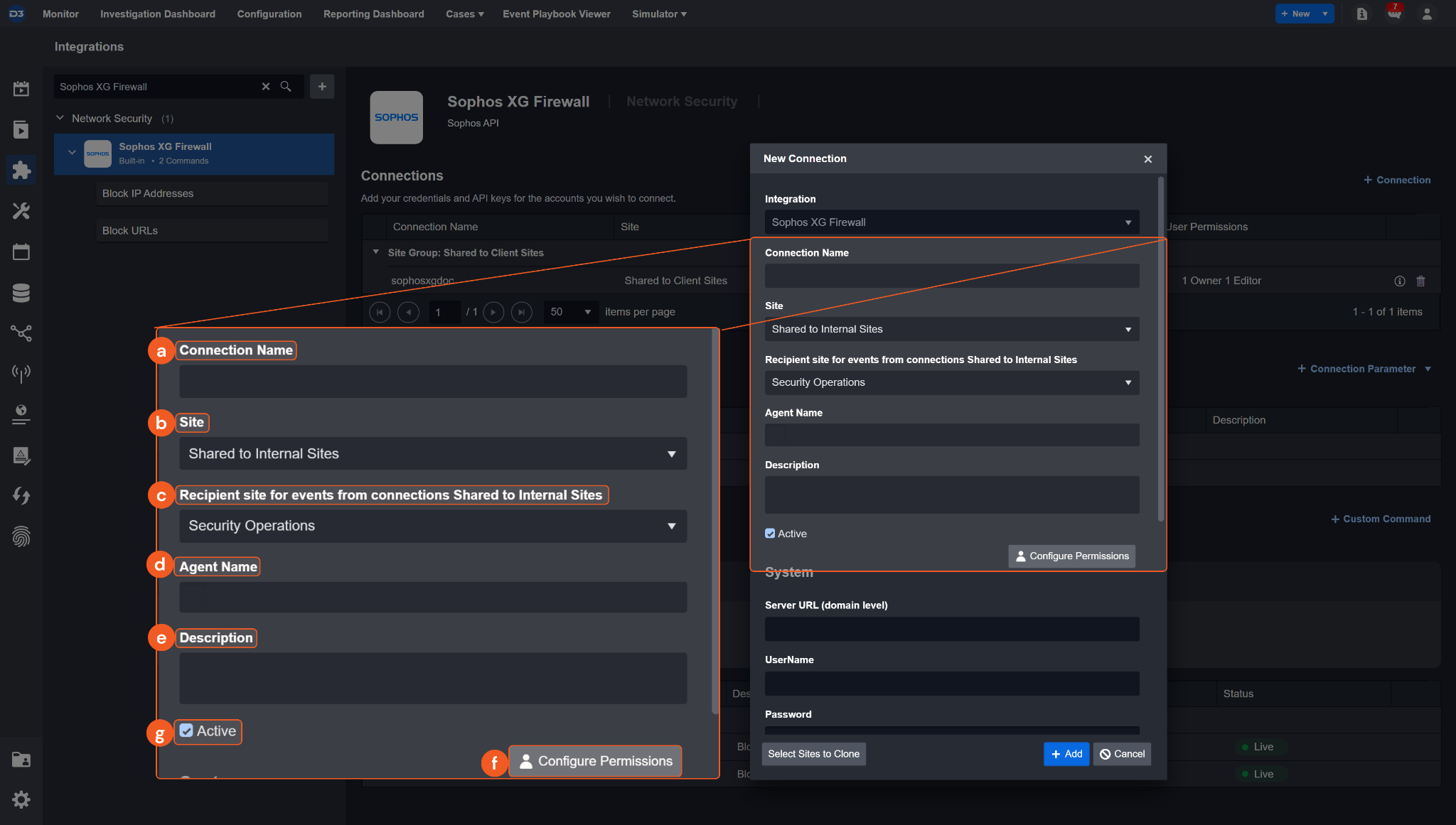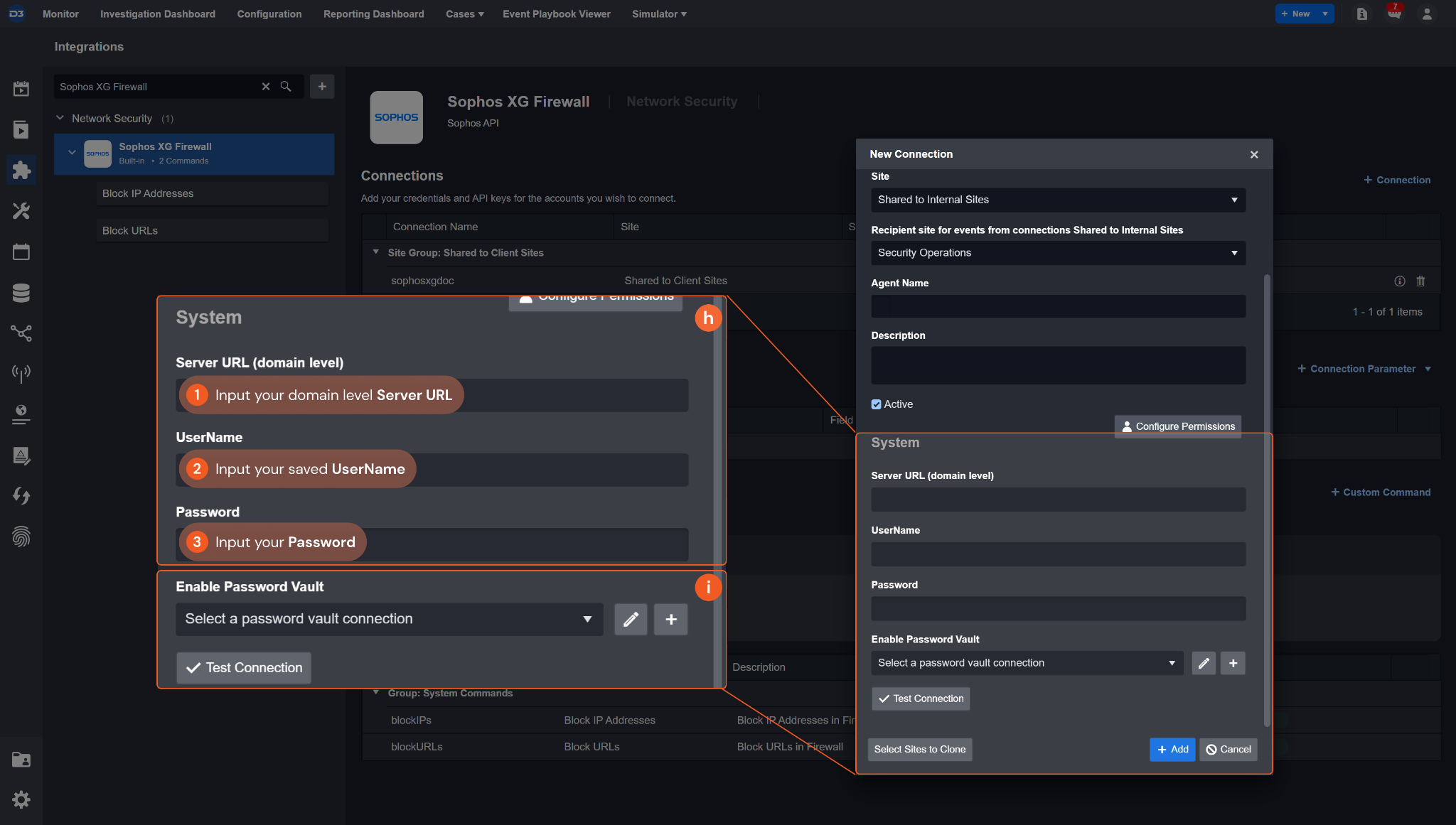Sophos XG Firewall (Deprecated)
LAST UPDATED: APR 11, 2025
Overview
Sophos XG Firewall is a next-generation firewall appliance that delivers visibility, protection, and performance for small branch offices to distributed enterprises. It offers features such as anti-malware, web security and URL filtering, application control, IPS, traffic shaping, VPN, reporting and monitoring.
D3 SOAR is providing REST operations to function with Sophos XG Firewall.
Sophos XG Firewall is available for use in:
D3 SOAR | V12.7.83.0+ |
Category | Network Security |
Deployment Options |
Connection
To connect to Sophos XG Firewall from D3 SOAR, please follow this part to collect the required information below:
Parameter | Description | Example |
Server URL (domain level) | The server URL of the Sophos XG Firewall integration. | https://192.1.1.1 |
UserName | The user name to establish the API connection. | admin |
Password | The password to establish the API connection. | Password |
Configuring Sophos XG Firewall to Work with D3 SOAR
To create an administrator profile with desired permissions, refer to Allow API access to administrators. You will be able to limit the administrator’s rights based on the profile.
Configuring D3 SOAR to Work with Sophos XG Firewall
Log in to D3 SOAR.
Find the Sophos XG Firewall integration.

Navigate to Configuration on the top header menu.
Click on the Integration icon on the left sidebar.
Type Sophos XG Firewall in the search box to find the integration, then click it to select it.
Click + New Connection, on the right side of the Connections section. A new connection window will appear.
Configure the following fields to create a connection to Sophos XG Firewall.

Connection Name: The desired name for the connection.
Site: Specifies the site to use the integration connection. Use the drop-down menu to select the site. The Share to Internal Sites option enables all sites defined as internal sites to use the connection. Selecting a specific site will only enable that site to use the connection.
Recipient site for events from connections Shared to Internal Sites: This field appears if you selected Share to Internal Sites for Site to let you select the internal site to deploy the integration connection.
Agent Name (Optional): Specifies the proxy agent required to build the connection. Use the dropdown menu to select the proxy agent from a list of previously configured proxy agents.
Description (Optional): Add your desired description for the connection.
Configure Permissions: Defines which users have access to the connection.
Active: Check the tick box to ensure the connection is available for use.

System: This section contains the parameters defined specifically for the integration. These parameters must be configured to create the integration connection.
1. Input the domain level Server URL of your Sophos XG Firewall instance.
2. Input your Sophos XG Firewall UserName.
3. Input your Sophos XG Firewall Password.Enable Password Vault: An optional feature that allows users to take the stored credentials from their own password vault. Please refer to the password vault connection guide if needed.
Test the connection.
Click Test Connection to verify the account credentials and network connection. If the Test Connection Passed alert window appears, the test connection is successful. You will see Passed with a green checkmark appear beside the Test Connection button. If the test connection fails, please check your connection parameters and try again.
Click OK to close the alert window.
Click + Add to create and add the configured connection.
Commands
Sophos XG Firewall includes the following executable commands for users to set up schedules or create playbook workflows. With the Test Command, you can execute these commands independently for playbook troubleshooting.
Block IP Addresses
Blocks the specified IP Addresses in the firewall.
Input
Input Parameter | Required/Optional | Description | Example |
IPs | Required | The IP addresses to block. | ["1.1.1.1","1.2.3.4"] |
IP Group Name | Required | The name of the IP group to add the IP addresses into. | suspicious_IP_group |
Output
Error Handling
If the Return Data is Partially Successful or Failed, an Error tab will appear in the Test Result window.
The error tab contains the details responded from D3 SOAR or third-party API calls, including Failure Indicator, Status Code, and Message. This can help you locate the root cause of a command failure.
Parts in Error | Description | Example |
Failure Indicator | Indicates the command failure that happened at a specific input and/or API call. | Block IP Addresses failed. |
Status Code | The response code issued by the third-party API server or the D3 SOAR system that can be used to locate the corresponding error category. For example, if the returned status code is 401, the selected connection is unauthorized to run the command. The user or system support would need to check the permission setting in the Sophos XG Firewall portal. Refer to the HTTP Status Code Registry for details. | Status Code: 404. |
Message | The raw data or captured key error message from the integration API server about the API request failure. | Message: IP Group Name Not Found. |
Error Sample Data Block IP Addresses failed. Status Code: 404. Message: IP Group Name Not Found. |
Block URLs
Blocks the specified URLs in the firewall.
Input
Input Parameter | Required/Optional | Description | Example |
URLs | Required | The array of URLs to block. | ["*.test3.com","*.test4.com"] |
URL Group Name | Required | The name of the URL group to add the specified URLs into. | suspicious_fqdn_group |
Output
Error Handling
If the Return Data is Partially Successful or Failed, an Error tab will appear in the Test Result window.
The error tab contains the details responded from D3 SOAR or third-party API calls, including Failure Indicator, Status Code, and Message. This can help you locate the root cause of a command failure.
Parts in Error | Description | Example |
Failure Indicator | Indicates the command failure that happened at a specific input and/or API call. | Block URLs failed. |
Status Code | The response code issued by the third-party API server or the D3 SOAR system that can be used to locate the corresponding error category. For example, if the returned status code is 401, the selected connection is unauthorized to run the command. The user or system support would need to check the permission setting in the Sophos XG Firewall portal. Refer to the HTTP Status Code Registry for details. | Status Code: 404. |
Message | The raw data or captured key error message from the integration API server about the API request failure. | Message: URL Group Name Not Found. |
Error Sample Data Block URLs failed. Status Code: 404. Message: URL Group Name Not Found. |
